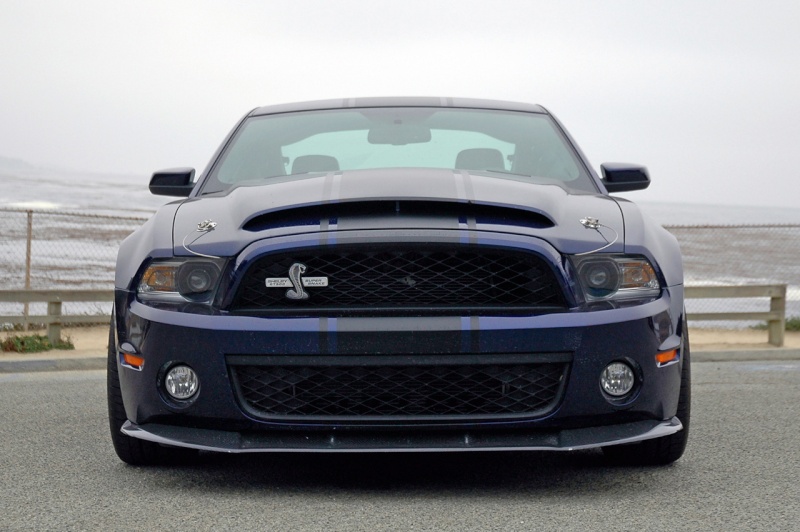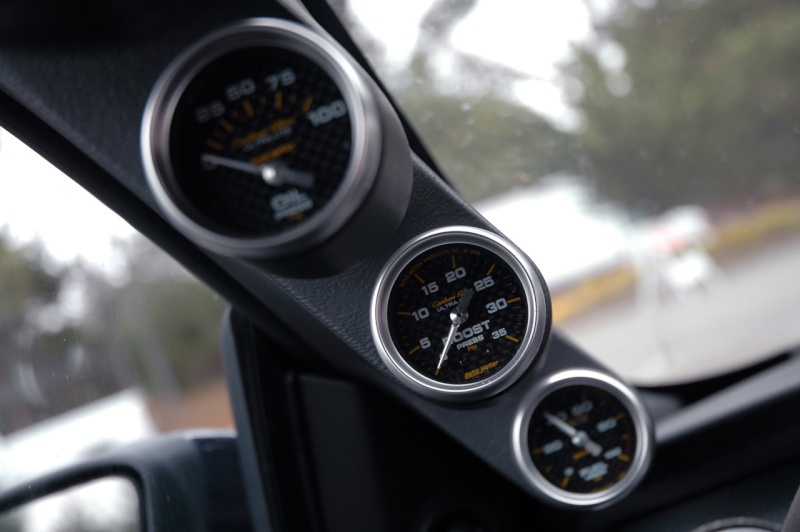
In just under ten months, this blogger has gone from not having been inside a Mustang in 13 years (and a used one at that), to driving, in this order, a 2010 Mustang GT, a Mustang GT with the Track Pack, a Shelby GT500 Mustang and a Roush 427R. That sequence also defines our order of favorites; every successive steed has made us say "We have a new favorite!" In Monterey, we were handed the keys to the brand new 750-horsepower Shelby GT500 Super Snake, and when we gave them back we not only said: "We have a new favorite," we declared "All hail, we have a new king!"

At its crudest, the equation for bewitched driving is simple: horsepower + handling = magic. If you can only have one, you'd probably go for handling since the motion of driving is most closely and kinetically tied to the dynamic act of handling. That basic breakdown is what has made the Dodge Viper a lot of fun, and the Lotus Elise a lot of fun to drive. Yes, we enjoy driving the Viper, too, but you know what we mean. Big horsepower is relatively easy. Great handling is relatively difficult. That's why big horsepower and great handling together is so mythical it's like the marriage of a unicorn and a centaur – you just don't see it. (Which might be a good thing, because we're not even sure such a union would be legal in most states.)
And in the case of the Shelby Super Snake, it can definitely turn into the highly illegal, very, very quickly.
We drove the 540-hp GT500 and really liked it, but it took a day on the race course and drag strip to scribble its name in our "Win" column. That car on long, open back roads – the roads it was meant for – was a hoot as long as things were smooth. On tight, bumpy, twisted knots of road, the car's live rear axle made us back off quickly, too scared we were going to go over a rather vertiginous cliff after bouncing into the opposite lane.
The 435-hp Roush 427R, by comparison, was just right. Fewer horses to pull the cart, but the suspension upgrades turned the car from a quarter horse into the kind of any-road-any-time sporting proposition we could get down with in SoCal. And 435 supercharged ponies are still plenty to get you from one corner to another quickly, no matter how closely spaced or far apart they are. The lesson again: manageable power.
So we wondered which side of the corral the 750-hp Super Snake – showing up with 315 more horsepower than the Roush, an entire V8 Mustang full of additional go – would fall on. The quick stats for comparison:
Ford Mustang GT: 4.6-liter V8, 315 hp, 325 lb-ft, five-speed manual, 3,550 pounds
Roush 427R: 4.6-liter supercharged V8, 435 hp, 400 lb-ft, five-speed manual, 3,688 pounds
Shelby GT500: 5.4-liter supercharged V8, 540 hp, 510 lb-ft, six-speed manual, 3,917 pounds
Super Snake: 5.4-liter supercharged V8, 750 hp, 710 lb-ft, six-speed manual, 3,944 pounds
The Super Snake adds a double century to the power and torque numbers of the next nearest Mustang – the one that felt nose heavy and hopped all over the place – with a negligible weight gain. That comes courtesy of a Ford Racing Supercharger upgrade kit and a JBA manifold and back system. If we only had the chart to decide how to drive, we'd look for the longest, smoothest road we could find. Or an undertaker.

Before that, though, we'd have to get acquainted with the way it looks. To our eyes, the GT500 is OEM badass – definitely brings the 'tude, but never gets close enough to the edge to go overboard. The Roush is striking-yet-smooth aftermarket badness. The Super Snake is Moloch. The Shelby hood is angrier, the 20-inch wheels that hide six-piston brakes up front look ginormous, the carbon fiber splitters appear to want to cut more than just air. You look at the Super Snake from almost any angle feel like withering as you ask, "What do you demand of me?" It should come with a permanent low hum and weird supernatural glow. And a tongue.
Inside, it's a Mustang, save for the three gauges mounted on the A-pillar for boost, fuel pressure and oil pressure, and the Shelby plaque. We only had the car for a few hours, so the plaque we never bothered looking at. The gauges we never had time to look at.
The car is mechanically a six-speed, but in practice it's a five-speed. First gear is good for parking lot speeds, but when you get down on the thing you have to shift immediately. It's like an appendix – still hanging around, but you're not really sure what it's good for; it's not like you couldn't pull away in second gear when you have 750 equines pulling for you.
It's first gear alone, though, that brought out an impossible-to-surmount-without-fancy-aids flaw – if you can even call it a flaw – in the Super Snake. You can forget about adhering to a non-smoking policy if you don't take good care with the throttle in first. In fact, the Super Snake will cut loose all the way up to fourth gear and triple-digit speeds, which about used up all the bravery we had.
The Ford Racing suspension with dynamic adjustable dampers, lowered springs, new stabilizer bars and front strut tower brace is outstanding, but even it and the Pirelli P-Zeros with which it's partnered couldn't stop the stampede. From a stop light, between trying to shift out of first quickly while not getting sideways (and failing almost every time to pull off both simultaneously), we left a lot of rubber on the road and a made a lot of mental notes to go a little easier on the gas next time.
But from second gear on this serpent is top notch on straights and through corners and, crucially, over bumps. We drove it over the same roads we had just been plowing in a Porsche Panamera 4S and Aston Martin DBS Volante, Carmel Valley Road, and the Super Snake did the trick so well we drove it further than both of those cars just to make sure we weren't missing anything or fooling ourselves. While there was a little wheel hop with the Super Snake, it wasn't anywhere near enough to make us think of backing off, and you were able to get back on the power so quickly that the grunt made up for the finesse of the other two cars. It's like the big hungry carnivore in the movies that overshoots corners but has more than enough scramble to stay in the chase. A little less maneuverabililty but a lot more muscle means it will work a little harder, but it is definitely going to eat you.
Which had us repeating this line in our head on the way back to return the car: "750 usable horsepower... 750 usable horsepower... unicorns and centaurs, living together..."

The only thing that interrupted our fancies was the fact that we could barely hear them on occasion. The Super Snake makes a lot of noise. And not just the loud engine and rumbling exhaust kind. The Roush 427R is no quiet child, but its burbling is even and not difficult to overcome with a sensible right foot and a radio. In the Snake, from 1,750 to 2,000 RPM the engine creates an uncomfortable resonance in the cabin. Below 2,500 there issues an attention-getting whine that isn't the supercharger. And that supercharger, by the way, always wants to spool up; do so much as take a deep breath and the supercharger kicks in. And when you give it the business, holy moly, the car sounds like Doc's DeLorean there's so much going on. Or the Owl's ship from The Watchmen. It gets busy in there.
But that doesn't mean we wouldn't take it, we'd just have to be in the mood for it. Which isn't a problem – there aren't too many headaches that would keep us from the almost chimeric thrill of 750 usable horsepower that comes in Drag Me to Hell packaging.
If you take it, though, we recommend you make a call to Pirelli and order a whole lot of horseshoes. You're gonna need 'em.







